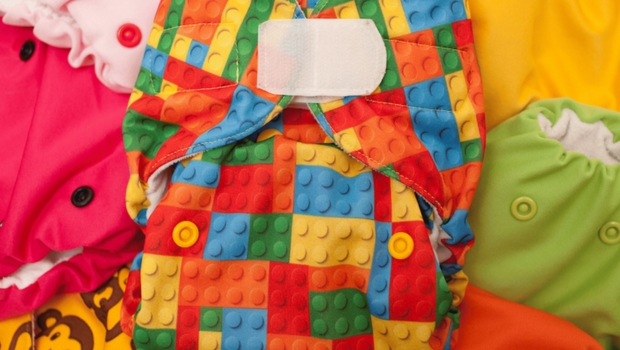The Case for Cloth Diapers: Saving Money and the Environment
Disposable diapers hit the shelves in 1948 and have become a household staple. The International Market Analysis Research and Consulting Group estimates that 28.8 billion diapers were sold in 2023 in the United States. Parents concerned with environmental, monetary and other associated costs of disposables are moving back to cloth diapering.
“Both my husband’s mom and my mom mentioned that they cloth-diapered. They said it was really no big deal. Cloth diapers used to be the norm just a few generations ago,” says Kate Sawyer, a water and wastewater professional in Durango, Colorado.
Health Benefits
Babies are more susceptible to harmful chemicals due to their thinner, more permeable skin. The U.S. Consumer Product Safety Commission does not require diaper manufacturers to test their products for toxins other than lead. A 2019 study published by the French Agency for Food, Environmental and Occupational Health and Safety tested 23 bestselling disposable diapers and found toxic substances, including volatile organic compounds like naphthalene, styrene, toluene, chlorobenzene, phthalates, formaldehyde, pesticides and dioxins. A 2000 study published in the journal Archives of Disease in Childhood showed that boys exhibited a higher scrotal temperature when wearing disposable diapers than cotton varieties, posing possible fertility issues in later life.
Cloth diapers are made of natural, breathable materials such as cotton, bamboo or hemp, which generally do not contain perfumes, polyacrylate (a super-absorbant polymer) or chlorine that can strip away protective bacteria, causing a baby’s skin to become dry and irritated. Look for organic versions free of toxins from the farm and factory.
Unlike disposables designed to absorb moisture quickly and keep it away from the skin, cloth diapers need to be changed as soon as they are wet or soiled, and the baby’s bottom must be cleaned well and allowed to dry before applying a fresh diaper.
Toddlers wearing cloth diapers can feel the wet sensation against their skin and are more aware of when they have relieved themselves, making potty training easier. According to an article in Parenting Science, approximately 60 percent of American children in 1947 were potty trained by 18 months old, whereas the average age rose to 37 monthsby 2004, in part due to the use of disposable diapers, researchers believe.
When washing cloth diapers, follow the manufacturers’ instructions, use recommended amounts of detergent, run an extra rinse cycle to thoroughly remove all the soap, and avoid fabric softeners or dryer sheets, as they can be irritants. Responding to parents that don’t want to deal with the messiness of cloth diapers, Sawyer says, “No matter what, you’re going to deal with poop as a parent. Using cloth diapers actually gives you a process to deal with poop, so when a blowout happens—cloth diaper or not—you can deal with it quickly and efficiently.”
A Cleaner Option
Each year, 3.6 million tons of disposable diapers are sent to landfills. The American Academy of Pediatrics estimates that a child will require up to 3,000 diapers in the first year, and about 8,000 by the time they’re potty-trained. Most disposable diapers are made of cellulose, polypropylene, polyethylene and absorbent polymers that take up to 500 yearsto break down. The fecal contents can also leach into groundwater.
Parents that use cloth tend to buy between 20 and 40 diapers, which can last up to 400 washes if they’re well maintained and can be repurposed into dust rags to extend their life. Although they usually do not pile up in landfills, cloth diapers still pose some environmental concerns. Hot water and energy are needed to wash and dry them. Cotton is also a chemically dependent crop, but when regenerative organic principles are employed, the cotton-growing process conserves water, protects biodiversity and avoids toxic fertilizers and herbicides.
Cheaper in the Long Run
The average cost of one disposable diaper is 29 cents; cloth diapers are about $2 to $21 each. “It can be expensive to get started [with cloth diapers], but the long-run savings more than make up for the up-front costs,” says Leah Black, a mom and founder of Cheeks Ahoy, a reusable baby-wipe company in Canada. “You don’t have to buy all brand-new stuff. Well-made cloth diapers will last much longer than your child’s diapering stage, so there is nothing wrong with looking for gently used cloth diapers.”
A Flexible Approach
Families that want the benefits of cloth diapering do not have to make it an all-or-nothing decision. Many use disposable diapers when a newborn first comes home because they require so many changes at that time, and then switch to cloth diapers once the child is a few weeks old. Some parents choose to use cloth diapers only during the day and avoid fuss by using disposables at night when they are tired and trying to get back to sleep. Others go with cloth diapers at home and disposables when they are out, so they aren’t carrying around soiled diapers at the grocery store or park.
Kelcie Ottoes is a frequent contributor to Natural Awakenings.




























